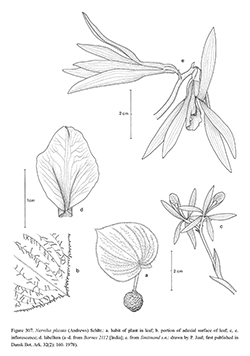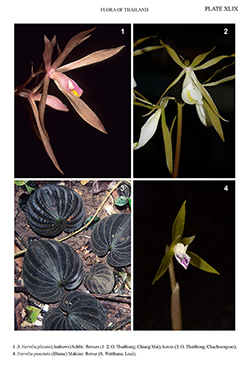e-Flora of Thailand
Volume 12 > Part 2 > Year 2014 > Page 566 > Orchidaceae > Nervilia
8. Nervilia plicata (Andrews) Schltr.wfo-0000251724
Bot. Jahrb. Syst. 45: 403. 1911; Seidenf., Dansk Bot. Ark. 32(2): 156, fig. 100. 1978; Seidenf. & J.J.Wood, Orchids Penins. Malays. Singap.: 137, fig. 56f–h. 1992; H.J.Su, in Editorial Committee of the Flora of Taiwan (ed.), Fl. Taiwan, ed. 2, 5: 979, t. 416. 2000; N.Pearce & P.J.Cribb, Fl. Bhutan 3(3): 60. 2002; S.C.Chen & S. W. Gale in Z. Wu et al. (eds), Fl. China 25: 200. 2009; Barretto et al., Wild Orchids Hong Kong: 282, fig. 234. 2011.— Arethusa plicata Andrews, Bot. Repos. 5: 321. 1803.— Pogonia plicata (Andrews) Lindl., Gen. Sp. Orchid. Pl.: 415. 1840. Fig. 307; Plate XLIX: 1–3.
Accepted Name : This is currently accepted.
Synonyms & Citations :
Description : Tuber whitish-beige, 12.5–32 mm in diameter, 3- to 5-noded. Leaf lamina flush with ground level or held a short way above, dark purple, brown or green with irregular olive-green or purple markings above, pale green or purple beneath, broadly ovate-reniform, 3.2–12.5 by 3.8–14.6 cm, coriaceous, pubescent along veins, 20-veined or more, base cordate, apex rounded or acute; petiole-like stalk erect, pale green, sometimes tinged purple, 0.7–3.5 cm long, 3–4 mm in diameter. Inflorescence 10.3–18.6 cm long, 2- (or rarely 3-)flowered; peduncle beige to dull maroon, ca 2 mm in diameter, bearing 2 or 3 tubular sheaths; floral bracts linear-lanceolate, one longer than the other, the longer one 3.1–12.5 by 0.4–1.2 mm, the shorter one ca 2 mm long. Flowers resupinate, nodding, opening widely; pedicel 2.2–5 mm long; ovary 4–6.8 mm long, ridged. Sepals and petals greenish-beige to brownish-purple, narrowly elliptic to linear lanceolate, apex acute to acuminate; sepals 22.8–34.9 by 2–4.4 mm, 3- or 5-veined; petals 21.8–33.5 by 1.8–2.8 mm, 3-veined. Labellum white with a longitudinal yellow strip, or with pink purple venation and suffused purple-rose or yellow along the centre, rhombic-ovate, 13.5–21.6 by 5.8–14.9 mm, obscurely 3-lobed at or above the middle; lateral lobes loosely embracing the column, rounded; mid-lobe broadly ovate, 5.5–8 by 4.8–7 mm, margin entire, apex obtuse rounded or truncate, longitudinally folded at the apex; labellum without ornaments. Column white, arched above the middle, 8.5–11.5 mm long; anther 1.2–2 mm in diameter; pollinia ca 1.8 mm long; rostellum protruding; stigma shield-shaped, concave. Capsule fusiform, 6-ridged, 14–16 mm long, ca 8 mm in diameter.
Thailand : NORTHERN: Mae Hong Son, Phayao, Chiang Mai (Doi Suthep), Chiang Rai, Lamphun, Lampang (Chae Son NP); SOUTH-WESTERN: Kanchanaburi; SOUTH EASTERN: Chachoengsao (Khao Ang Rue Nai), Chon Buri (Bang Saen), Chanthaburi (Pong Nam Ron); PENINSULAR: Surat Thani (Ban Kop Kaep).
Distribution : India (type), Pakistan, Nepal, Bhutan, Bangladesh, S China, Taiwan, Myanmar, Vietnam, Malaysia, Indonesia, the Philippines, Papua New Guinea, Australia.
Ecology : Terrestrial growing in shade in shallow soils over shale, limestone or granite bedrock in disturbed deciduous or evergreen forests, or among bamboo, often forming large colonies, 200–1,000 m alt. Flowering: March–June, leaf present from May–October.
Vernacular : Wan phaen din (ว่านแผ่นดิน)(Chiang Rai); wan phaen din yen (ว่านแผ่นดินเย็น).
Notes: This is another widespread species complex and many names have been proposed for entities which differ in size, colour and in the outline of floral parts. However, intermediates exist and different colour forms may occur in close proximity. Both yellow-lipped (e.g. Collins s.n. -K!; Maxwell 96-554 -BKF!) and pink/purple-lipped (e.g. Sangkhachand 638 -C!; Hosseus 604 -K!) forms are found in Thailand. An examination of patterns in genetic variation throughout the range is required.


